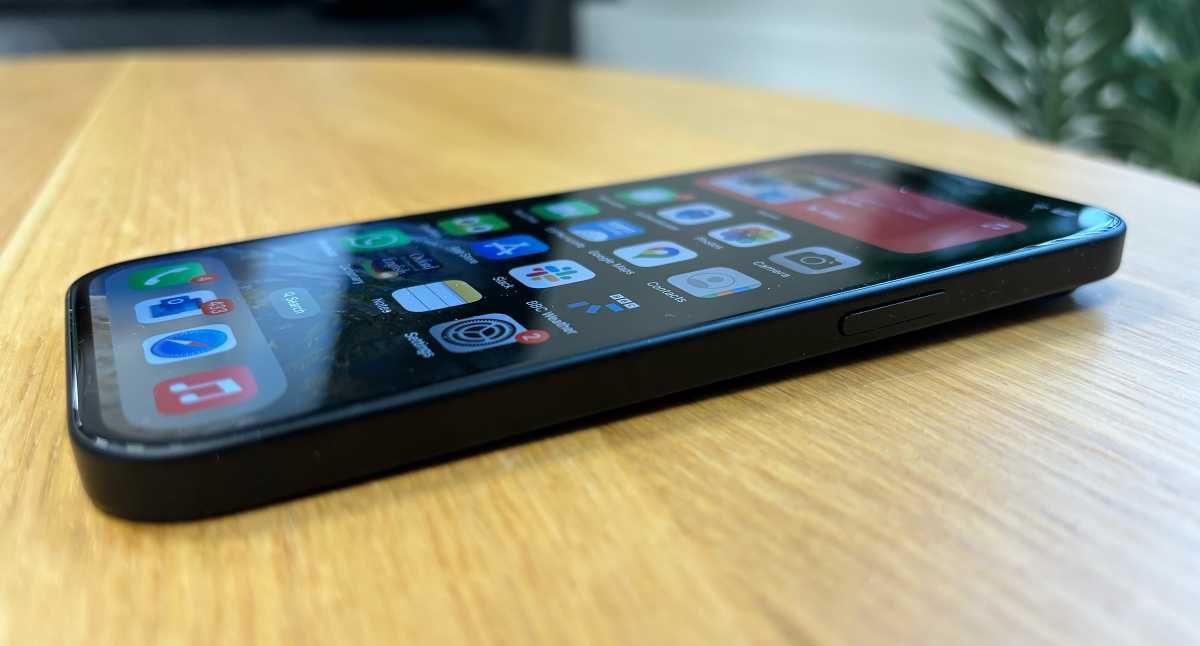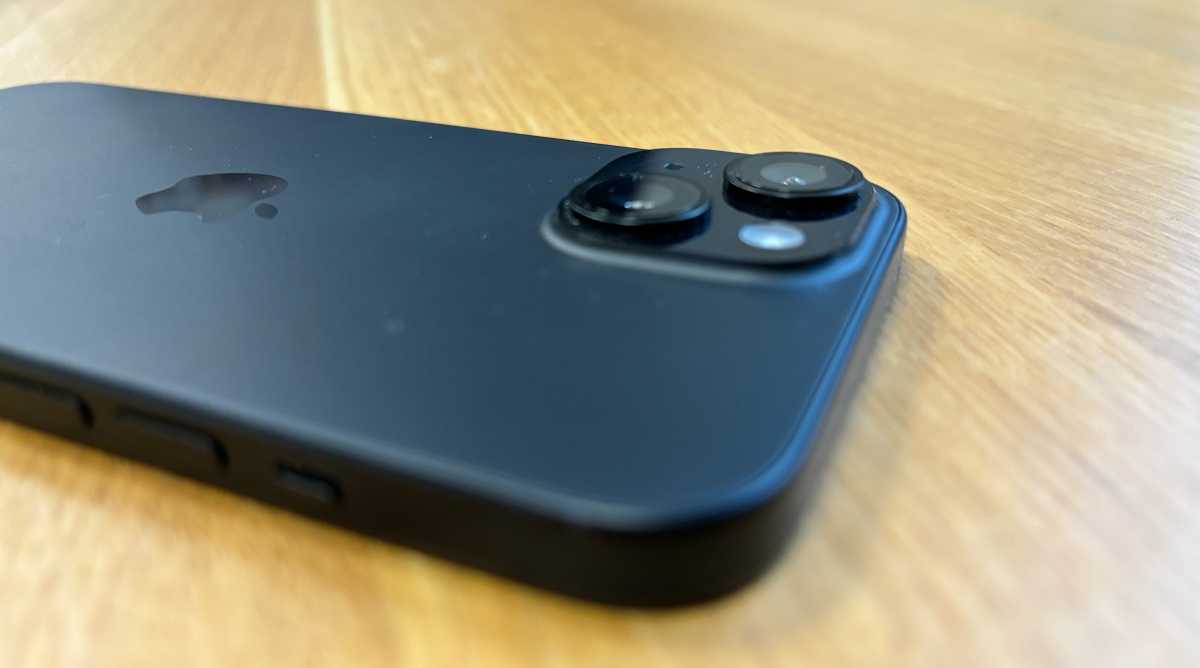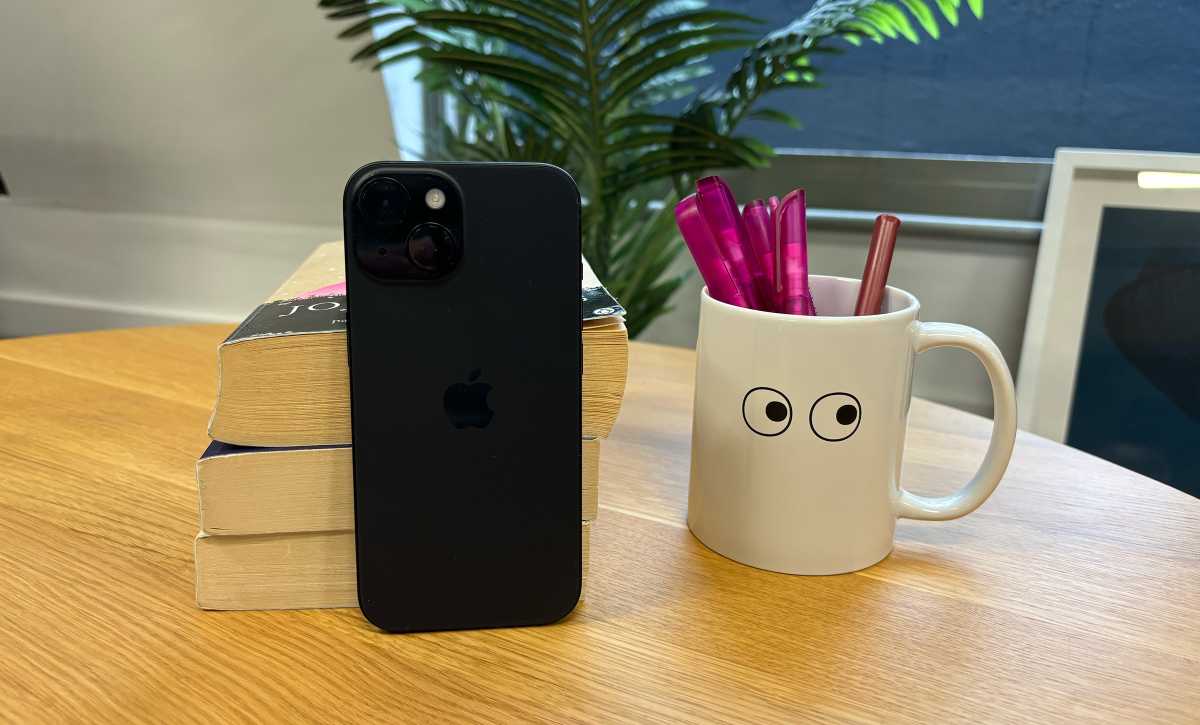
 At a glance
At a glance
Expert’s Rating
Pros
- Brilliant camera setup
- Fast processor
- Clever Dynamic Island feature
Cons
- Processor lacks future-proofing of A17
Our Verdict
The iPhone 15 isn’t an exciting product, thanks to its old-fashioned design and similarity to last generation’s iPhone 14. But it is a very solid smartphone with a strong feature set at (by Apple’s standards) an affordable price.
Price When Reviewed
From $799
Best Prices Today: Apple iPhone 15

$829

$829.99
Every fall Apple releases four iPhones, but this excess of choice seems less intimidating once you realize that there are really just two phones wearing different clothing. The iPhone 15 Pro Max is essentially a bigger version of the iPhone 15 Pro–same processor, same camera setup, same features–while the iPhone 15 discussed in this article is a shrunk-down version of the 15 Plus which we previously reviewed last year.
In this article, I’ll be focusing on the areas where the iPhone 15 differs from the 15 Plus: namely portability, the screen, and battery performance. I’ll sum up our findings in the other departments as well, but for a fuller rundown read my in-depth review of the larger model.
Design & build
- Old-fashioned but attractive design
- Fits neatly in the hand or pocket
If you want the latest look to emerge from Cupertino’s design studios, head on over to the Pro range, with its light titanium frame and Action Button. The iPhone 15 is more of a classic design, pretty much sticking to the iPhone 14’s aesthetic playbook but switching from Lightning to a USB-C port on the bottom edge.
It has flat edges and squared-off corners in the style Apple brought back in 2020 with the iPhone 12 (and which was itself a nod to the iPhone 5 from 2012). The twin camera lenses on the rear project outwards a couple of millimeters from the module, which itself is raised from the rear surface of the phone; so if you try to place the phone screen-up on a table, it won’t sit flat. If that matters to you, I’d strongly recommend the use of a case.

David Price / Foundry
Having used the iPhone 15 Plus as my primary phone for four months or so before beginning this review, I was struck by how much more comfortably the standard 15 sits in the hand. I have probably medium to large hands for an adult male–I can happily play a ninth on the piano–but the Plus can be awkward to use with one hand, with the pinky finger instinctively drifting to a supportive position underneath. That doesn’t generally happen with the 15, which is easily supported by the meat of your palm on one side and a few fingers on the other.
It weighs roughly 15 percent less than the 15 Plus and fits more easily in a pocket. (The 15 Plus does slide into a jeans pocket fairly easily, but you have to be more aware of putting it in and taking it out at the correct angle.) It’s just generally, and obviously, a more portable device than its larger sibling, but there are downsides to this such as a lower-capacity battery and a smaller and less immersive screen.
Screen quality
- Sharp, colorful 6.1-inch screen
- But may feel small to some
- No ProMotion or always-on
That screen measures 6.1 inches from corner to corner, which is a decent size by most measures (and certainly in comparison to the sub-5-inch screens Apple turned out for years) but feels small next to the 6.7-inch iPhone 15 Plus and 15 Pro Max. Not to mention the big-screen Android handsets pushing or occasionally even exceeding the 7-inch mark.
The size of screen you want is a personal choice and nothing I say is likely to push you bigger or smaller than you’re comfortable with. But I would recommend experimenting occasionally with borrowed handsets or in-store samples; I’m a long-time fan of Apple’s standard-size Pro phones, but since last fall have been growing to love the 15 Plus and its 6.7-inch screen. Those used to larger screens, in turn, might find if they approach things with an open mind that they find the standard 15’s superior pocketability more than makes up for its slight reduction in real estate.
Size aside, the screen’s a good one, with excellent brightness (boosted from last year for better performance outdoors), sharpness, and color reproduction. It doesn’t get the ProMotion adaptive refresh rate and always-on features that remain Pro exclusives, but it does the simple stuff–making images, videos, and app interfaces look great–very well indeed.
Cameras
- 48MP f/1.6 and 12MP f/2.4 rear cameras
- 12MP f/1.9 front camera
As with many of the elements discussed in this review, the 15’s camera setup is the same as that of the 15 Plus. It has twin (48MP f/1.6 main and 12MP f/2.4 Ultra Wide) rear-facing camera lenses, and a single (12MP f/1.9) front-facing camera for selfies.

David Price / Foundry
Still no triple cameras for the non-Pro models, then, but this is a big step forward from 2022’s iPhone 14, whose main camera lens was specced at just 12MP. It’s such a massive increase, indeed, that it effectively acts as a substitute for the telephoto lens that non-Pro iPhones miss out on, because the iPhone 15 can crop into an image without dropping below the level of detail we’re used to. This is why the 15 gets a 2x optical zoom, and it’s a very welcome addition: you may find, as I do, that 2x simply makes sense as your default selection. The 15 Pro goes up to 3x optical zoom, and 15 Pro Max all the way up to 5x, but these are features you’re likely to use less often than reliable old 2x.
Other than this handy upgrade, the 15’s photographic chops are precisely what we’ve come to expect from Apple in recent years: sharp, crisp, colorful photos with masses of detail, along with a startling ability (thanks to Smart HDR 5) to cope with difficult lighting conditions. It’s also exceptional at grabbing high-quality video, while you can take impressive Portrait-mode selfies with the front camera even though it doesn’t have a second lens.
Battery life & charging
- 3,349mAh capacity
- Solid battery life
- Comfortably lasts a full day
The iPhone 15 features a 3,349mAh battery, compared to 4,383mAh on the larger Plus model, and longevity away from a charge is accordingly lower: Apple rates the iPhone 15 for up to 20 hours of video playback, whereas the 15 Plus gets an estimated 26 hours and the 15 Pro 23 hours.
In practice, of course, the main criterion for success is being able to get from one charging session to the next without running out of juice. Since most of us charge overnight, or at least on some sort of daily schedule (charging for a couple of hours each morning may be better for long-term battery health, although the 80% Battery Charge feature is a great preservative), the main thing is that the phone can get through a full day’s cycle without dying. And the iPhone 15 can, with ease. Indeed, lighter users may find that even after forgetting to charge overnight, they will make it through a decent chunk of a second day too.
But this is all subjective since a phone’s battery performance in ‘normal’ use is hugely dependent on what you do with it. For a more scientific approach, we use the battery test in the Geekbench 4 benchmarking suite, where the iPhone 15 scored 6390 or a time of 10 hours and 39 minutes.
Before you panic, this isn’t a measure of the life you should expect in real use. Geekbench is running a deliberately strenuous battery test so we can compare different devices under laboratory conditions: it’s for comparisons, not predictions. Here’s how some other iPhones got on in the same test:
All of these devices would be expected to last significantly longer than this in general use, unless you’re the sort of person who spends all day running phone benchmarks.
On the charging front, the iPhone 15 features a USB-C port like all of its late 2023 siblings, which means older Lightning-based cables and docks won’t be of much use any longer. (Note also that while you get a USB-C-to-USB-C cable in the box, you don’t get a power adapter to go on the end of it.) The 15 is capable of fast charging provided you pair it with a 20W or higher adapter. Under such circumstances, Apple says it can charge from 0 to 50% percent in 30 minutes. In testing, our test unit actually managed 54 percent.
Performance
- A16 Bionic is fast and powerful… for now
- Less future-proofed than A17-equipped Pro models
The iPhone 15 is equipped with the same A16 Bionic processor and 6GB of RAM) as the 15 Plus. This is a chip that first graced an iPhone back in fall 2022, and is a generation behind the A17 Pro in the latest Pro models.
That doesn’t mean it’s slow: far from it, in fact. In the multi-core component of the Geekbench 6 speed test, it scored a creditable 6,551 points, far surpassing leading Android devices such as the Google Pixel 8 (2,842), Samsung Galaxy S23 (4,994), and the OnePlus 11 (5,209). Indeed, it wasn’t all that far behind the A17-equipped iPhone 15 Pro, which scored 7,431. Here’s how it compares to other recent iPhones:
Graphically, the 15 should be able to comfortably handle anything that any of the games on the App Store can throw at it. In the 3DMark testing suite it consistently (with one exception) returned scores slightly lower than those of the 15 Plus, but both have 5-core GPUs so that’s probably just experimental variation. This is a powerful gaming phone that won’t let you down now or in the next few years… but that older chip means it will start to feel slow around a year earlier than the iPhone 15 Pro.
Price & availability
The iPhone 15 was launched in September 2023, and starts at $799 / £799.
- 128GB: $799 / £799 / AU$1,499
- 256GB: $899 / £899 / AU$1,699
- 512GB: $1,099 / £1,099 / AU$2,049
You can buy direct from Apple, or browse our roundup of the best iPhone 15-series deals.
Verdict: Should you buy the iPhone 15?
The iPhone 15 isn’t an exciting product, thanks to its old-fashioned design and similarity to the previous generation. Nor would we, on balance, recommend making the upgrade if you currently own even an iPhone 13 from 2021. For $799 ($829 unlocked), there simply aren’t enough improvements to justify the cost.
For everyone else, however, the iPhone 15 is a very solid smartphone with a strong feature set at (by Apple’s standards) an affordable price. The screen is sharp, the camera setup is superb, battery life is decent, and the processor is fast. Chuck in 5G support and the clever Dynamic Island, and you’ve got another example of Apple’s straightforward excellence.

David Price / Foundry
Tech specs
- A16 Bionic processor (6-core CPU, 5-core GPU)
- 6.1-inch 2556×1179 460ppi Super Retina XDR display
- Dual-lens rear camera: 48MP f/1.6 Main, 12MP f/2.4 Ultra Wide; up to 2x optical zoom
- 12MP f/1.9 front camera
- Smart HDR 5
- 128/256/512GB storage
- Estimated battery life: Up to 20 hours video playback
- Fast charge: Up to 50% charge in 30 minutes with 20W adapter
- Wi-Fi 6, Bluetooth 5.3, 5G
- USB-C charging/data connection
- IP68 dust and water resistance (maximum depth 6m up to 30 minutes)
- 5.81 x 2.82 x 0.31 inches (147.6 x 71.6 x 7.8mm)
- 6.02 ounces (171 grams)






